S
electing and booking your shooting location can be a daunting challenge. Is a permit required? How do you get the owner’s permission? What does your location scout need from you?
How do you handle insurance? Do you need a film location release?
In this article, we’ll unpack the location securing process step-by-step, and provide you with a film location release form for use on your next production.
finding film locations
1. How to pick your shooting region?
Before you start scouting individual locations, consider which cities would make the best hosts for your film, as some region offer tax or rebate incentives.
In Southern California, Riverside County offers fee-free permits and even allows free filming on county property. In Santa Monica, you can shoot on private property without a permit as long as you have the property owner’s permission.
To learn about the costs and requirements of shooting in public property, contact the film commission in that city.
RESEARCH INCENTIVES AND PERMITTING COSTS
Before you start scouting individual locations, consider which cities would make the best hosts for your film, as some region offer tax or rebate incentives.
In Southern California, Riverside County offers fee-free permits and even allows free filming on county property. In Santa Monica, you can shoot on private property without a permit as long as you have the property owner’s permission.
To learn about the costs and requirements of shooting in public property, contact the film commission in that city.
CONSIDER SHOOTING LOGISTICS FOR THE LOCATION
Your shooting region should be accessible to your cast and crew.
Some shooting locations may be beautiful, but if the transportation or lodging costs are too high, you may need to pass on it.
A good location scout can help guide you in this regard.
Another thing to keep in mind:
As you gather all of your contacts and location information, you can record and organize everything in your contacts page in StudioBinder.
You have built a career in film and entertainment, so it is great to have the ability to keep every piece of new information stored and organized while you produce each of your projects.
hiring a location scout
2. Why you should consider hiring a location scout?
You can either hire a location scout, or go out on your own. Although it may cost a bit extra to hire a location scout, the amount of time it’ll save you could pay for itself. It really comes down to the opportunity cost.
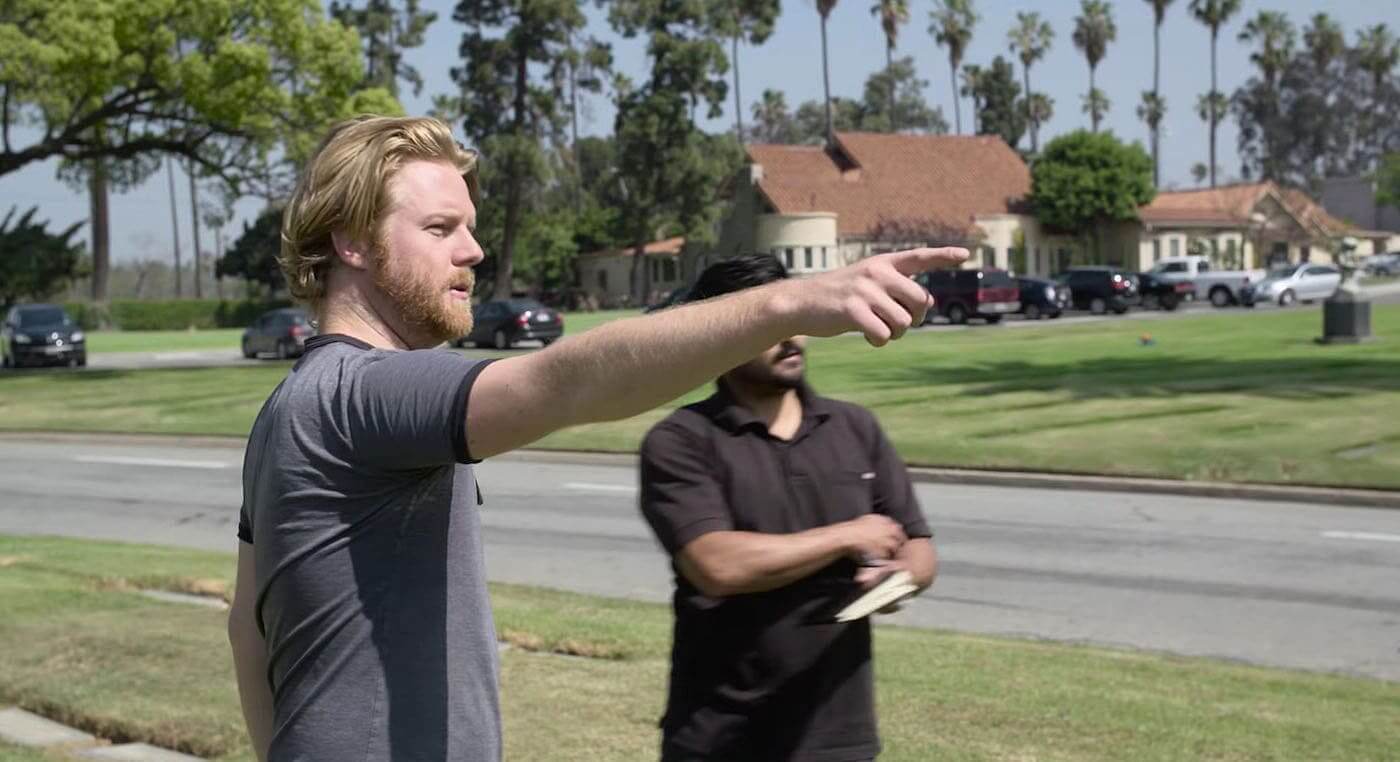
Why you should consider hiring a location scout?
IF YOU GO IT ALONE, CONSIDER A FILMING LOCATION SOLUTION
If you need to navigate this process, a filming location app may be helpful.
One I suggest is Wrapal, whose goal is to create a win-win offering for filmmakers and property owners.
Just like AirBnb, users can find vetted filming locations or list their own.
Hiring a professional can save you time...
Then the pricing is negotiated and ground rules are communicated within Wrapal, which makes a commonly frustrating process very turn-key.
Similar to AirBnb, giving and receiving reviews can boost a location manager's reputation for future transactions.
stay organized and prepared
3. Location Scouting Checklist
Every location comes along with its own logistical considerations. Here are some of the most common questions to ask yourself:
PRO TIP: LOCATION SCOUTING
If you’re short on time, you or your location scout can bring copies of your location agreement release form with you. When you find a location that you like, have the owner sign the location agreement release right on the spot.
secure film location
4. Communicate with the location owner?
PITCHING A PROPERTY OWNER (SCRIPT BELOW)
If you’re going to be shooting in a private location, now it’s time to call up the property owner.
We’ve transcribed the script for you below:
“Hi, is the manager or owner in please?”
(Allow them to respond. If they’re not in, leave a message.)
“Okay, let me just leave my name and number if possible.
My name is [your FULL NAME]. I’m an independent film producer.
We’re doing a [SHORT FILM] that we’re going to be submitting to film festivals and online. We’re going to be shooting in June. We need the use of a convenience store for a couple of scenes, and we’d like to film in your store.”
(Allow them to respond.)
“We wouldn’t need it for too long. It’ll probably take [1-2 nights] depending on how it goes, preferably after you guys close, like at [10:30 AT NIGHT] so we wouldn’t interrupt your business.
(Then ask if they have any questions. If you’re leaving a message simply conclude with the following…)
So let me give you my number just so you have it. Hopefully you can pass it along to the owner. The number is [YOUR NUMBER]. Thanks!”
ASK IF THEY HAVE ANY QUESTIONS
Most property owners have never seen a film production before so they'll have a bunch of questions.
Describe your production accurately. Don’t tell them you’re a small indie crew when you plan to show up with forty extras!
If you’re operating on a tight budget, you’re more likely to secure the location for free if you get creative with compensation (such as meals, credit, or if it’s a business, a shout out on their business website or social media channels.)
Pro TIp
Be empathetic. A film crew can be very disruptive when a production enters a business or home. People who aren’t in entertainment don’t realize just how long or chaotic production can be. I’ve seen many situations where people invited us to shoot, expecting the whole thing would only take a few minutes, unprepared for the twelve-hour workday.
SET A TIME TO DELIVER THE LOCATION RELEASE FORM
Once the property owner agrees, you’ll want to get it in writing just in case they change their mind. A location release form is a requirement before you step foot on their property with any equipment, and it protects both parties.
Try to execute on the agreement as soon as possible before the shoot; at least a week or two in advance.
If you haven't already done a tech scout, you'll want to before you secure the location. You don't want to sign papers and move forward until you know the location works for your team and your production.
StudioBinder | How to Tech Scout Like A Pro
When all is ready, you can email the location with the release form attached.
However, keep in mind the location owner is giving you a place to shoot - a little extra attention and face-to-face time can go a long way to secure the location and ensure a smooth experience on set.
PRO TIP: LOCATION RELEASE FORM
For a quicker signing experience, fill in as much information as possible on the location release form prior to sending (or seeing) the location owner. Once the agreements are fully executed, make sure the location owners receives a copy.
location release form
5. Free Location Release Form Template
Here are the major sections of a typical location release, which you’ll also find in our Location Release Form Template.
IDENTITY:
This is where both the location and the filming project are identified. Make sure to include the location name (if available) and the full address — nothing vague here. If required, add a note about where within the property you have permission to film, a necessity if you’re only permitted to access certain areas.
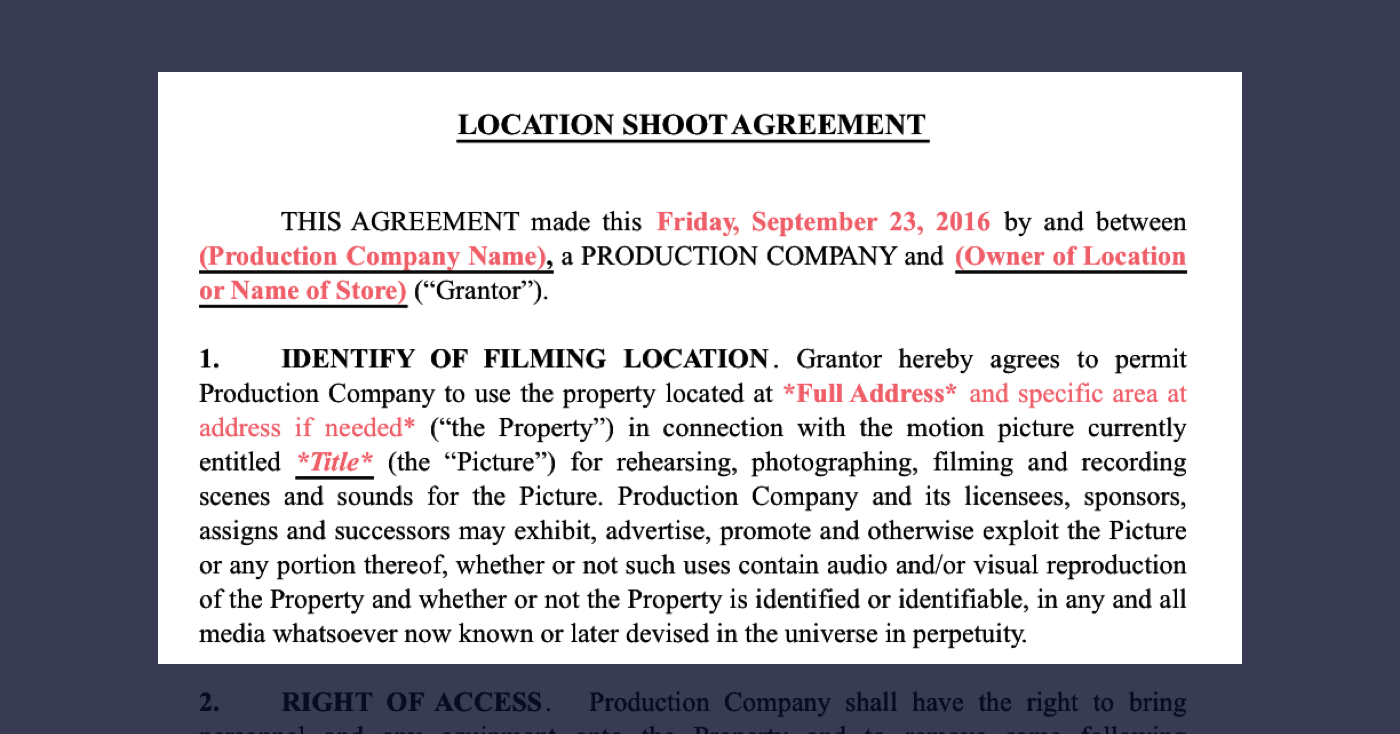
RIGHT OF ACCESS:
This defines what the production company is allowed to do at the location.
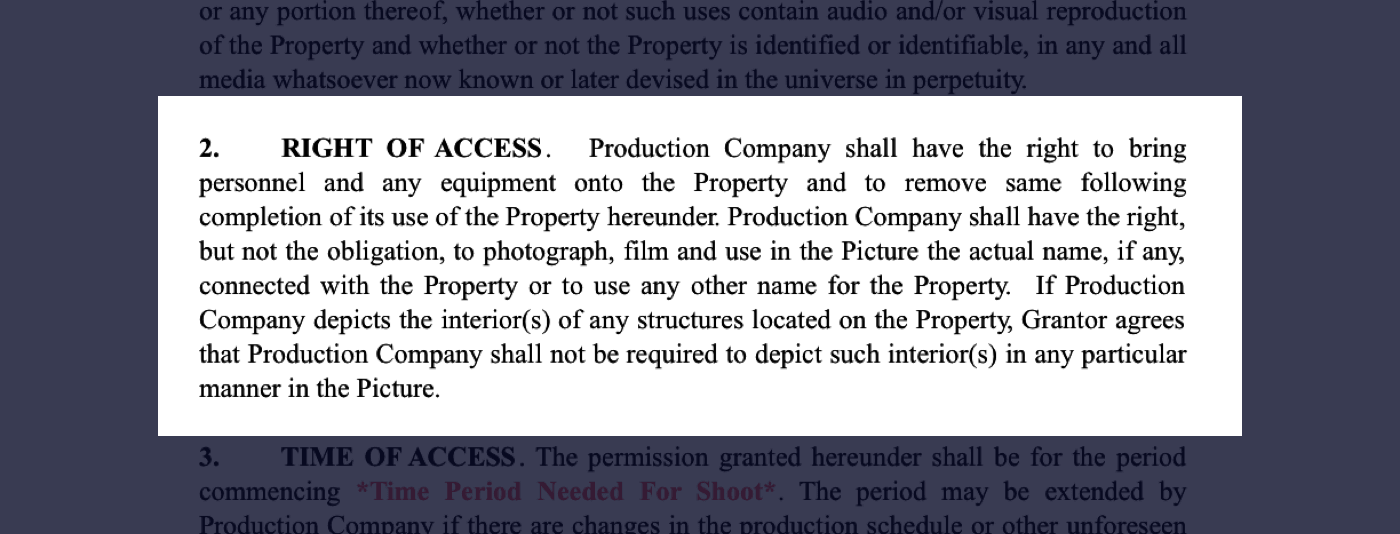
Location Shoot Agreement - Right of Access
TIME OF ACCESS:
This defines when and for how long the location owner will permit the production to access their property. Push for as much time as you can here.
It’s common for location owners to get upset if you go over schedule, and either demand more money or kick you out.

Location Shoot Agreement - Time of access
COMPENSATION:
Define exactly what and when the production will compensate the location owner for use of the location.

Location Shoot Agreement - Payment
ALTERATIONS TO LOCATION:
Over the course of production you might need to make changes to the location (e.g. painting the walls, hanging pictures, etc.). Regardless of whether or not the location owner will notice your alterations, you need to get permission to make these changes, and change things back at the production’s expense.
There’s typically language in this section stating that the location owner has authority to permit modifications to the property, or frees you from responsibility in the event of ill-described ownership.
For example, if your friends are letting you shoot in their apartment (that they are renting), they technically do not have the legal authority to permit you to modify the apartment. Therefore, if you modify it, and your friend gets in trouble, this clause keeps you out of trouble.
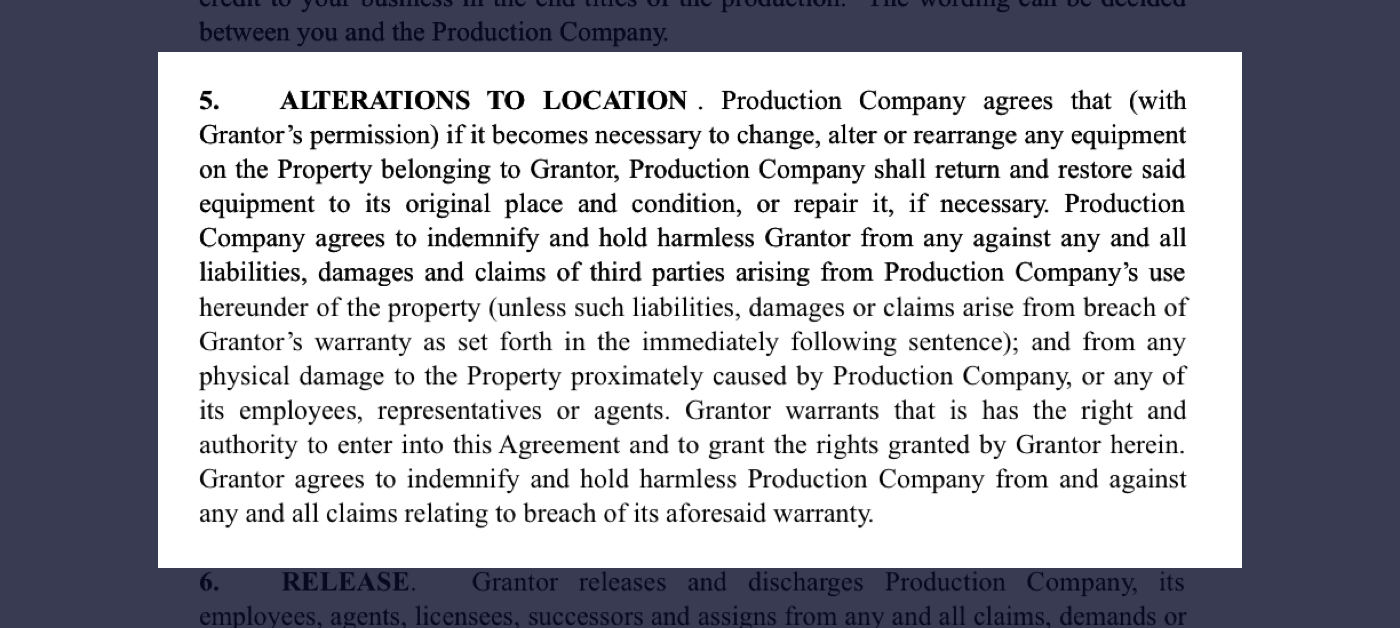
Location Shoot Agreement - Alterations to Location
RELEASE:
This is why this document is called a “Location Release Form” (some people also call it a “Film Location Agreement Form”). This section gives production permission to depict the location on-screen!

Location Shoot Agreement - Release
LEGAL DETAILS:
Usually the last section of a Location Release Form, this is where the agreement is localized to the laws of a particular state (typically, the state that you’re shooting in; not necessarily the production company’s home-base.)
There’s usually a clause here with language about “successors, assigns, heirs, executors, etc.”, which is important for maintaining your chain-of-title. This allows you to transfer the permission the contract grants to someone else.

Location Shoot Agreement - Miscellaneous
SIGNATURES:
As with any contract or agreement, both parties need to sign the agreement before it’s legally binding. Typically, the location scout doesn’t have the legal authority to bind the company into agreements - even location agreements. The producer should therefore sign all necessary documents.
Once you’ve filled out the location release form template and your location owner signs it, you can secure your location permit from the city or county!
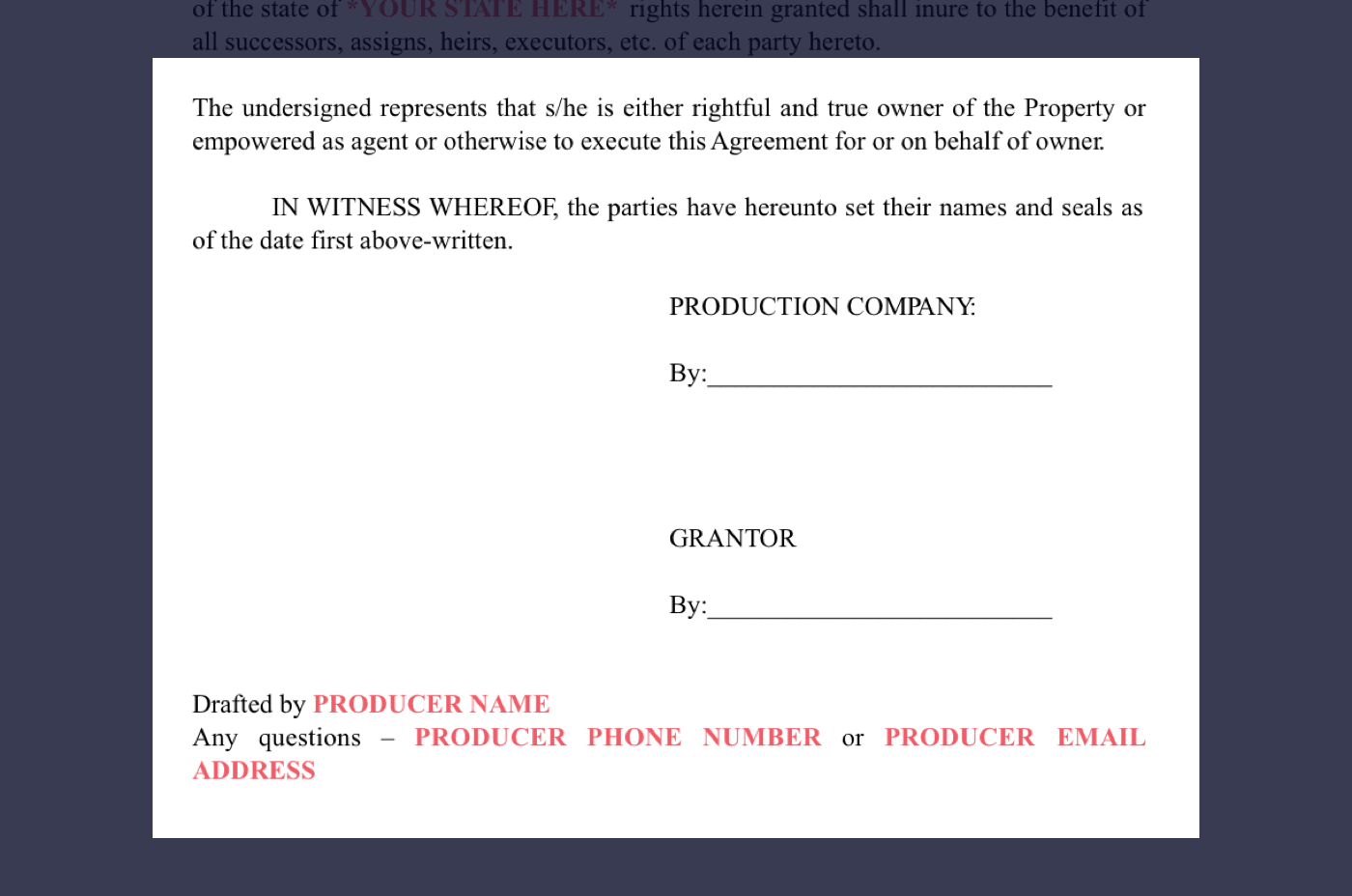
Location Shoot Agreement - Signatures
Related Posts
location scouting tips
6. Be a good steward of your location
When shooting, remember this is someone’s home or business...
Treat it with care.
- Protect fragile things like hardwood floors or glass furniture by laying cardboard or furniture pads.
- Don’t walk on the grass unless you’ve been given permission to do so.
- When finished, return everything to its original condition.
- Take out the trash at the end of the day.
If you are a good steward, the location owner is more likely to treat the next filmmaker with kindness and generosity. We all benefit from that.
For a refresher on etiquette, check out 6 Tips For Proper Film Set Etiquette.
We love to provide resources and templates to filmmakers. Just please remember, this article should be construed as informational, not legal advice. StudioBinder does not provide or offer legal advice to its readers.
StudioBinder, its editors and authors will not be held responsible for any legal issues the reader might encounter based on the subjects found in this post.
As always, we recommend you consult a legal expert for advice on release forms and agreements. This disclaimer assigns you, our readers, all responsibility for your own decisions.
FREE Download: Film Location Release Form Template
"Planning to secure a shooting location for a film project? Download this location release template for peace of mind."
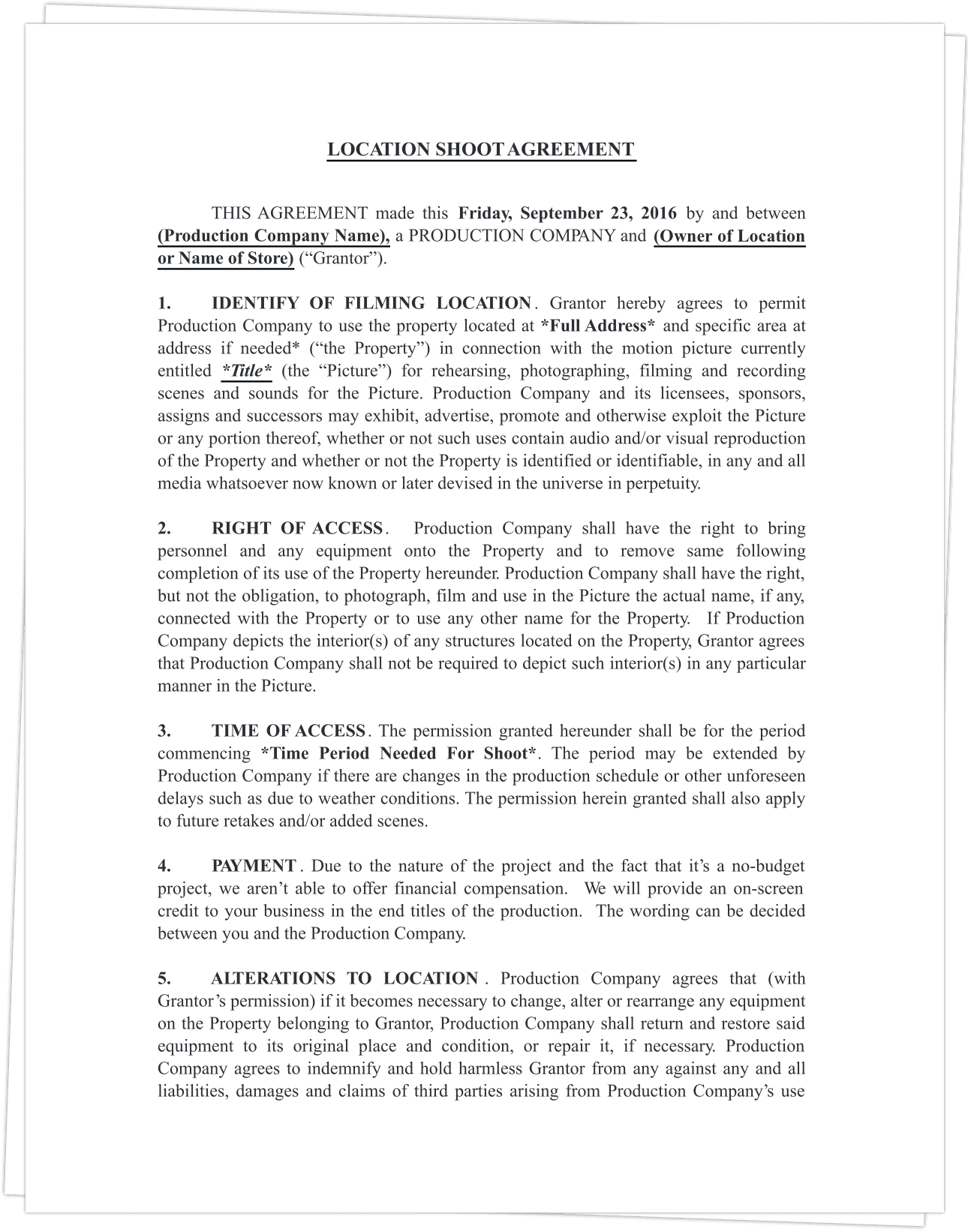
Download your FREE Location Release Template.
Just enter your email address and we'll instantly send it to you!
up next
Schedule the “Hidden” Shoot Locations
Check out our post on Finding and Scheduling the "Hidden" Shoot Location in a Script where we show you how to find locations in your script that may not be initially obvious without a bit of pre-production experience.
Up Next: Find the “Hidden” Shoot Locations →
Manage talent & film crew contacts, all in one place.
Create and share mobile-friendly contact lists, call sheets, calendars and more. Complete video project management for producers & coordinators.
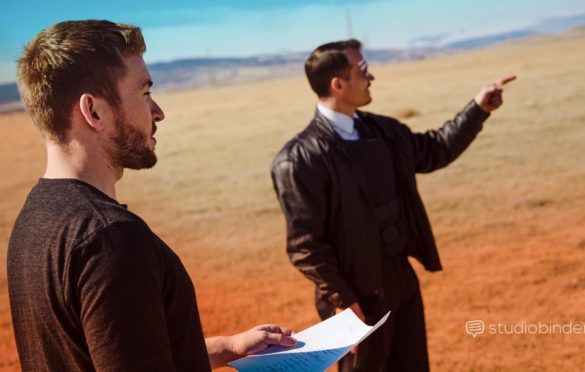
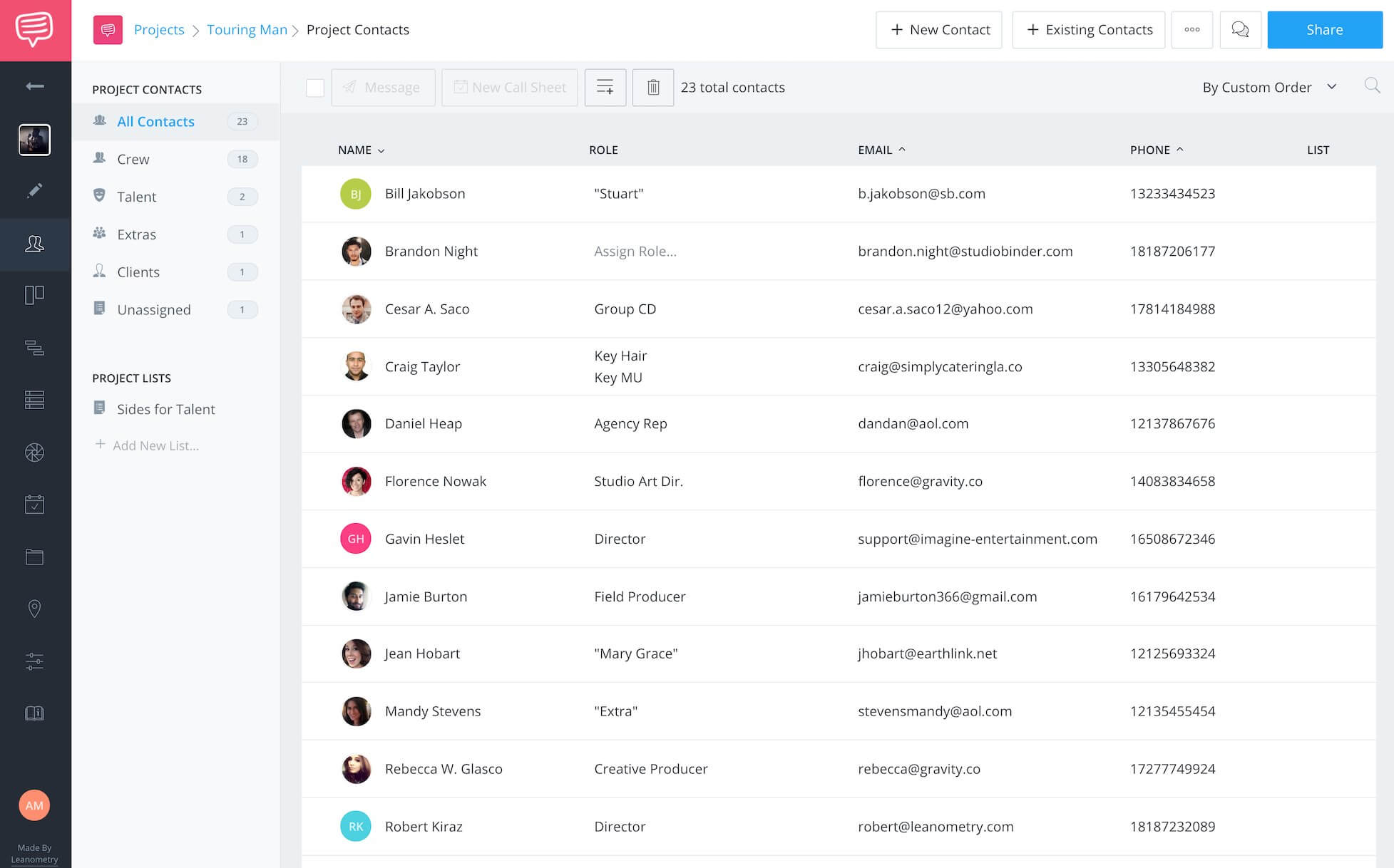
Thanks for the sharing information on film permission, nice blog.
Thank you very much – invaluable.